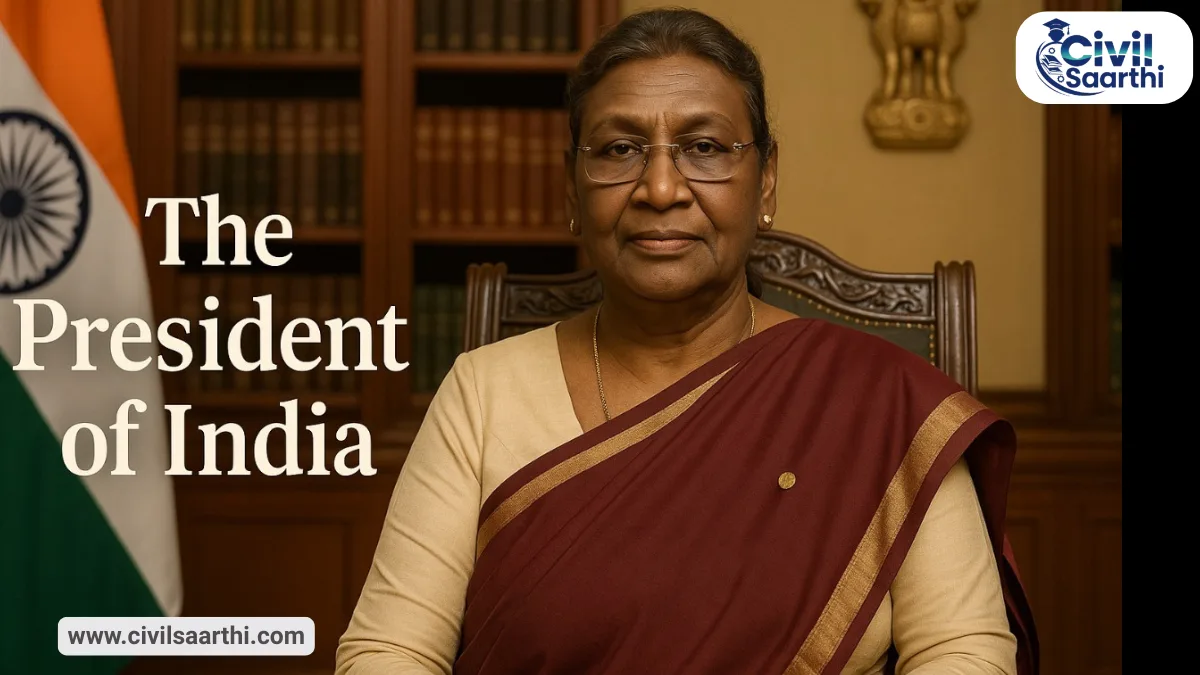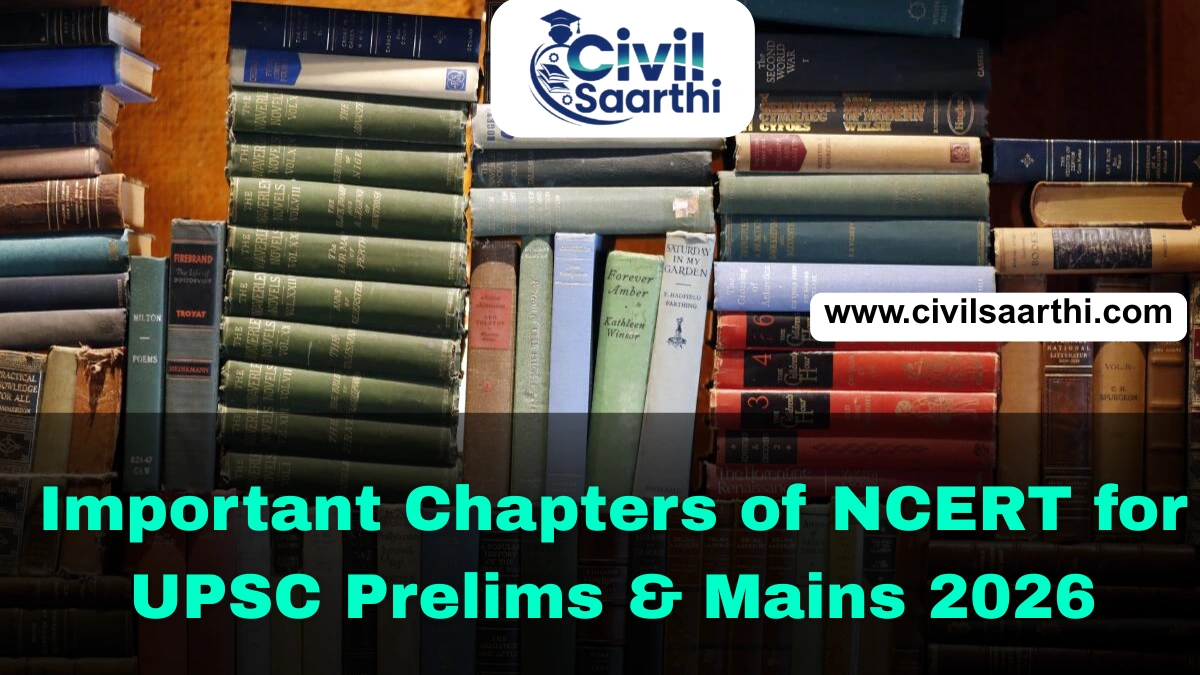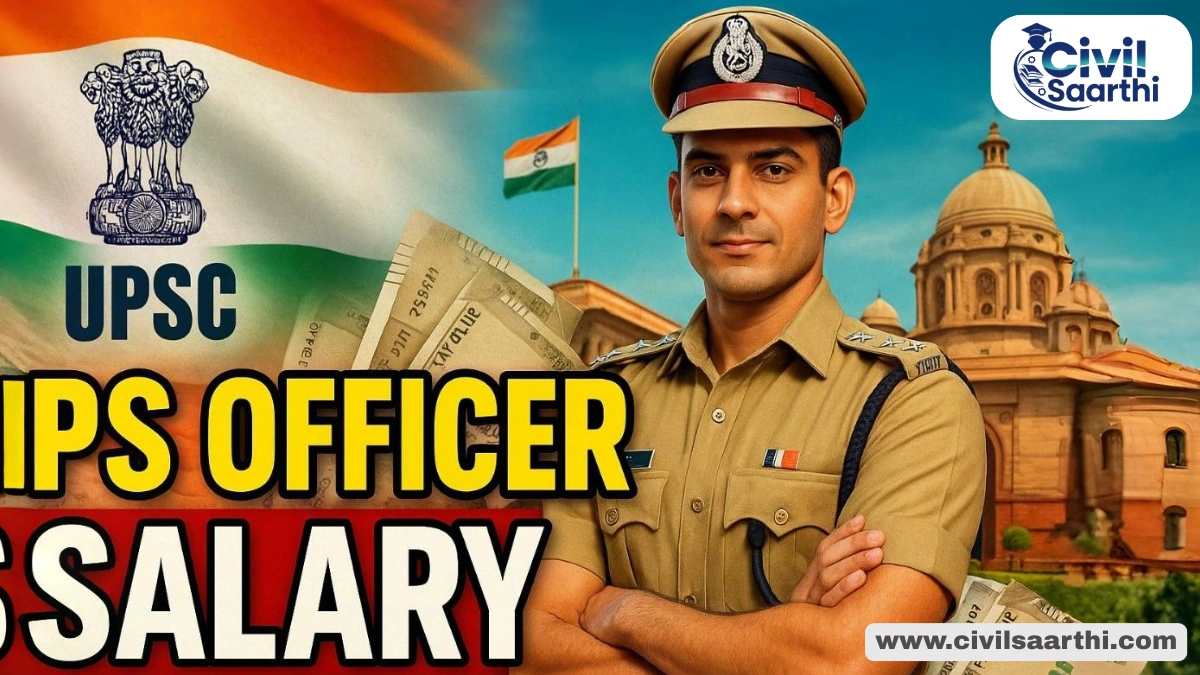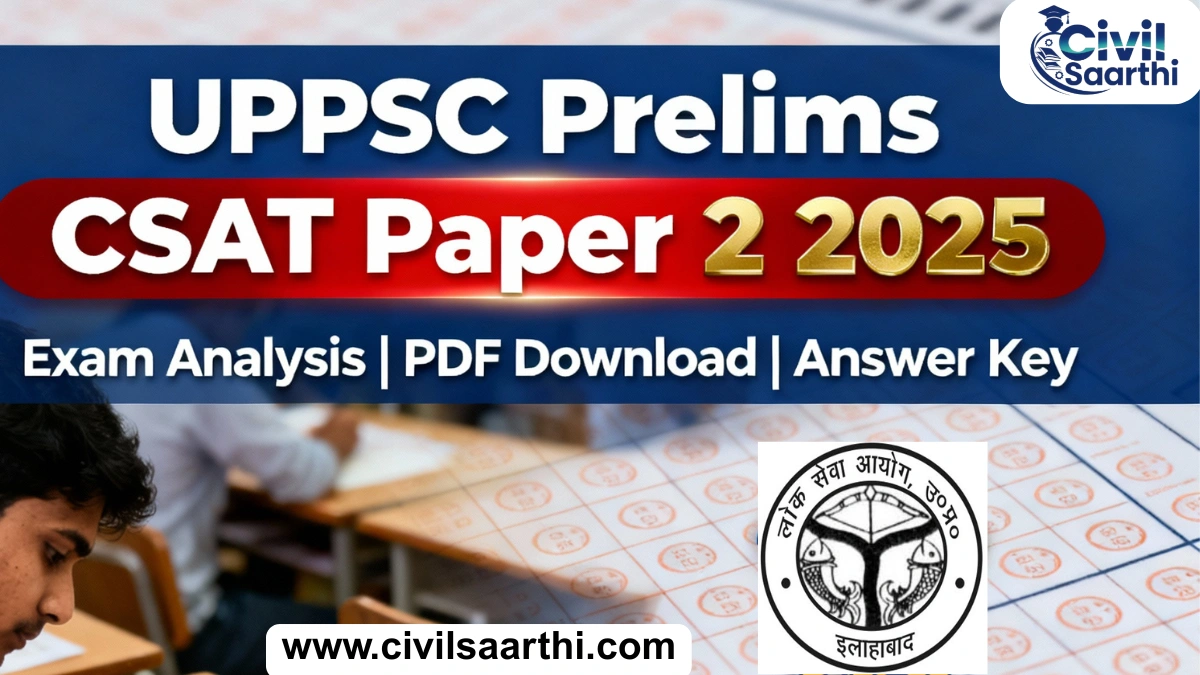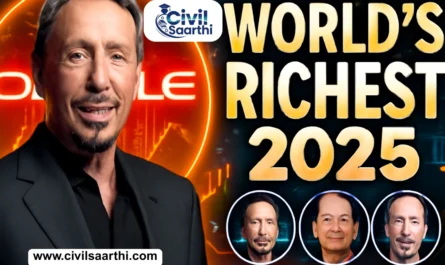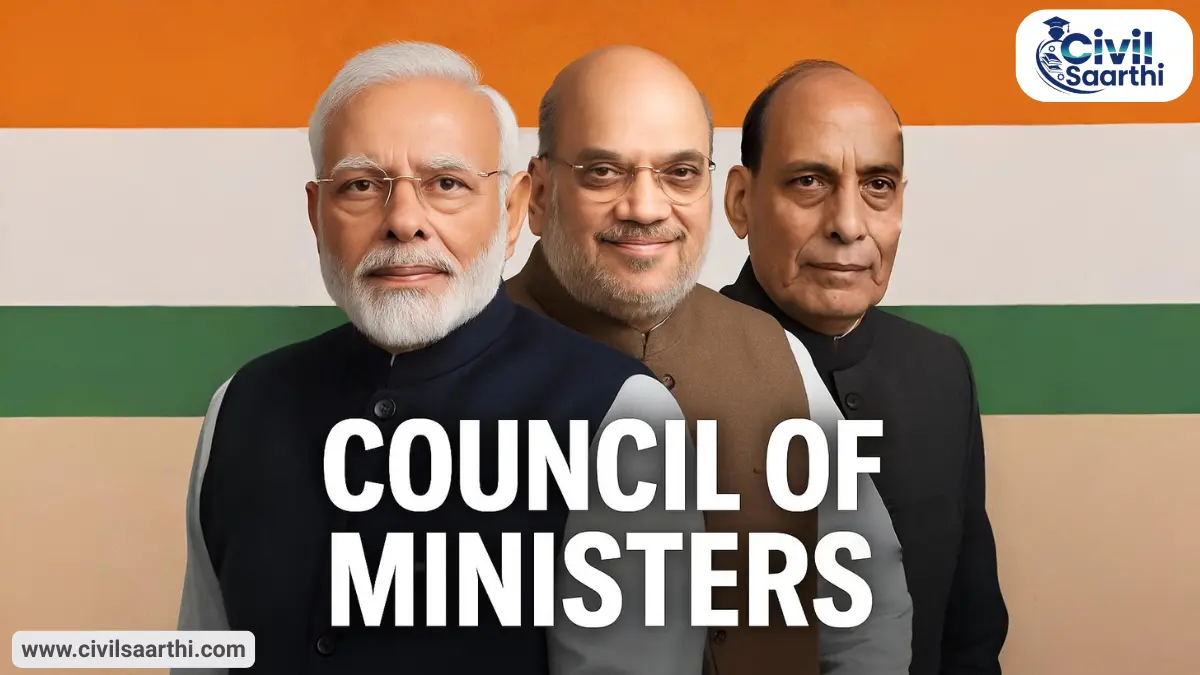The President of India is the constitutional head of the Indian Republic, representing the unity and integrity of the nation. Though largely ceremonial, the office plays a pivotal role in upholding democratic governance, constitutional morality, and crisis management. For UPSC aspirants, the President’s office forms a core part of Indian Polity, featured frequently in both Prelims and Mains.
The President of India
The Indian Constitution envisages a parliamentary system of government in which the President is the nominal executive and the Prime Minister is the real executive. The President is the highest constitutional authority in the country and represents the sovereign authority of the nation. The office is modeled on the British Crown but with significant constitutional limitations. The President acts as a link between the executive, legislature, and judiciary.
Constitutional Status and Evolution
Articles 52 to 62 in Part V of the Constitution deal with the President’s office. Article 52 states that there shall be a President of India. Unlike the hereditary monarch of Britain, the President of India is elected and serves for a fixed term. The position is rooted in constitutional provisions and democratic traditions.
Constitutional Status and Evolution | |
| Feature | Description |
| Office | Constitutional Head of the State |
| Article | Articles 52 to 78 in Part V |
| Election | Indirect by Electoral College |
| Term | 5 Years (Can be re-elected) |
| Powers | Executive, Legislative, Judicial, Emergency, and Diplomatic |
| Removal | Impeachment under Article 61 |
Who is a President, and what is his/her constitutional position?
Understanding the position of the President is essential to grasp India’s constitutional framework. As per The President of India is the ceremonial head of the Indian State and the commander-in-chief of the armed forces. Although the executive powers of the Union formally rest with the President, they are exercised by the Prime Minister and the Council of Ministers.
Who is a President, and what is his/her constitutional position in Indian Polity? | |
| Constitutional Aspect | Description |
| Role | Nominal Head of the Indian Union |
| Powers | Acts on the aid and advice of the Council of Ministers |
| Responsibility | Upholds the Constitution |
| Type of Executive | Nominal Executive under Parliamentary system |
| Equivalent Role | Similar to British Monarchy in structure but differs in constitutional duty |
Election of the President
The President is elected by an electoral college as mentioned in Article 54. The electoral college is composed of:
- Elected members of both Houses of Parliament (Lok Sabha and Rajya Sabha).
- Elected members of the Legislative Assemblies of the states.
- Elected members of the Legislative Assemblies of the Union Territories of Delhi and Puducherry.
Notably, nominated members of Parliament or state legislatures are not part of this electoral college. Similarly, members of the Legislative Councils in bicameral states like Uttar Pradesh, Bihar, Maharashtra, etc., are also excluded. This composition ensures that both the Union and States have appropriate say in the election, consistent with India’s federal structure.
Voting System and Method: Proportional Representation by Single Transferable Vote (STV)
The election is held through a system of proportional representation by means of the single transferable vote, and the voting is done by secret ballot. This method ensures that the elected President has broad-based support, not merely a simple majority.
Each voter (i.e., MLA or MP) does not cast a vote for just one candidate. Instead, they rank the candidates in the order of their preference (1, 2, 3, etc.). If no candidate receives the required quota in the first count, the candidate with the least number of votes is eliminated and their votes are transferred to the second preferences indicated on those ballots. This continues until a candidate reaches the quota.
Calculation of the Value of Votes
The Constitution seeks to maintain uniformity among states and parity between the Union and states in the election process. This is done by assigning different vote values to MLAs and MPs.
The use of the 1971 Census for calculating the value of votes in the Presidential election was mandated by the 84th Constitutional Amendment Act, 2001.

Non-Participants in the Election Process of President of India
The Constitution of India provides a well-defined electoral college for the election of the President under Article 54, ensuring a balance between the Union and the states. However, not every legislator or public representative has the right to vote in the Presidential election.
- Nominated members of the Rajya Sabha do not participate in the Presidential election, as they are not elected by the people or the state legislatures.
- Nominated members of the Lok Sabha are also excluded from the electoral college since they lack a direct electoral mandate.
- Nominated members of the State Legislative Assemblies are not eligible to vote in the Presidential election as only elected members are included in the electoral college.
- Members of State Legislative Councils (MLCs) in bicameral states such as Uttar Pradesh, Maharashtra, Bihar, and Karnataka are excluded from voting since the Constitution includes only Legislative Assemblies.
- Members of the Legislative Assemblies of Union Territories that do not have an elected assembly (such as Chandigarh, Lakshadweep, Andaman & Nicobar Islands, Ladakh, etc.) are not part of the electoral college.
- Only elected MLAs of Delhi and Puducherry, which are the only Union Territories with legislative assemblies, are included as per the 70th Constitutional Amendment Act, 1992. Others are excluded.
- Ordinary citizens of India do not have the right to vote in the Presidential election since it is an indirect election conducted through elected representatives.
- Members of Panchayats (Gram Panchayats, Panchayat Samitis, and Zila Parishads) are excluded because they are part of local self-government, not state legislatures.
- Members of Municipal Bodies (Municipal Corporations and Municipal Councils) are also excluded from the process as they are not part of the state or national legislative structure.
- Ministers at the Centre or in States, if they are not elected members of Parliament or State Assemblies at the time of election, do not have voting rights in this context.
- Persons holding offices of profit or government officials who are not elected members of the eligible legislative bodies cannot participate in the voting.
- Disqualified or suspended legislators, whose membership has ceased or is under suspension at the time of election, are not eligible to vote unless reinstated before polling.
Role of the Election Commission of India in Presidential Election
The Election Commission of India (ECI), under Article 324, is responsible for conducting the presidential election. The ECI notifies the schedule, scrutinizes nomination papers, conducts polling and counting, and declares results. The entire process is tightly regulated to ensure fairness, transparency, and adherence to constitutional norms.
The ECI also sets up polling booths in State Legislative Assemblies and the Parliament, issues identification guidelines for electors, and oversees any disputes or challenges regarding the process.
Qualifications, Oath, Term, and Conditions Qualifications
- Must be a citizen of India.
- Must have completed 35 years of age.
- Must be eligible for election to the Lok Sabha.
- Must not hold any office of profit under the Government of India or any state government.
Oath: Administered by the Chief Justice of India, the President swears to preserve, protect, and defend the Constitution and the law.
Term: The President holds office for five years but is eligible for re-election. The President continues in office until a successor is elected.
Privileges:
- Immunity from criminal proceedings during tenure.
- Civil proceedings can be initiated only after two months’ notice.
- Cannot be arrested or imprisoned during tenure.
Powers and Functions of the President
The President exercises powers under several heads:
Executive Powers:
- Appoints the Prime Minister and other ministers on the advice of the Prime Minister.
- Appoints Governors, the Attorney General, the Comptroller and Auditor General, Election Commissioners, UPSC members, Finance Commission members, etc.
- All executive actions of the Union are taken in the name of the President.
Legislative Powers:
- Summons and prorogues Parliament, and dissolves the Lok Sabha.
- Addresses Parliament at the beginning of the first session after each general election and at the commencement of the first session each year.
- Gives assent to bills or withholds assent (except for money and constitutional amendment bills).
- Can return a non-money bill once for reconsideration.
- Can promulgate ordinances under Article 123 when Parliament is not in session.
Judicial Powers:
- Appoints judges of the Supreme Court and High Courts.
- Has the power to grant pardons, reprieves, respites, and remissions of punishment under Article 72.
Emergency Powers:
- Can declare National Emergency under Article 352.
- Can impose President’s Rule in states under Article 356.
- Can declare Financial Emergency under Article 360.
Diplomatic Powers:
- Represents India in international affairs.
- Ratifies international treaties and agreements.
- Sends and receives diplomats.
Military Powers:
- Supreme Commander of the Defence Forces.
- Appoints chiefs of Army, Navy, and Air Force.
Discretionary Powers:
Although the President is constitutionally bound to act on the advice of the Council of Ministers, there are certain situations where discretion is exercised:
- Appointment of Prime Minister when no single party has a clear majority.
- Dismissal of a Council of Ministers if it has lost the confidence of the Lok Sabha.
- Dissolution of the Lok Sabha when no viable alternative government can be formed.
- Returning a bill for reconsideration.
- Reserving state legislation for the consideration of the President.
Emergency Powers
- National Emergency (Article 352):
- Can be declared due to war, external aggression, or armed rebellion.
- Central government assumes greater control over state matters.
- Fundamental Rights under Article 19 are suspended.
- President’s Rule (Article 356):
- Invoked when the state machinery fails to function constitutionally.
- State legislature may be suspended or dissolved.
- Executive powers of the state are assumed by the President.
- Financial Emergency (Article 360):
- Can be proclaimed when the financial stability or credit of India is threatened.
- The President can reduce salaries of government officials and judges.
Ordinance-Making Power
Under Article 123, the President can issue ordinances when Parliament is not in session. Ordinances have the same force as laws but must be approved by Parliament within six weeks of reassembly. Ordinances cannot be re-promulgated indefinitely. In the D.C. Wadhwa case, the Supreme Court held that repeated re-promulgation is unconstitutional.
Role in Parliamentary Functioning
The President plays a central role in the functioning of Parliament:
- Inaugurates the Parliament after general elections.
- Addresses joint sessions.
- Can summon joint sittings of both Houses in case of deadlock over ordinary bills.
- Grants assent to bills.
- Lays annual financial statements before Parliament.
How is the President of India Impeached?
Impeachment is the process by which the President can be removed from office for violation of the Constitution under Article 61. This is the only ground mentioned in the Constitution for removal, and the process is deliberately made rigid to preserve the dignity of the office.
How is the President of India impeached? | |
| Step in Impeachment Process | Description |
| Initiation of Motion | By either House of Parliament with 1/4th members signing the resolution |
| Notice Period | 14 days’ notice before taking up the resolution |
| Investigation | The second House investigates the charges |
| Voting Requirement | 2/3rd majority of total membership in both Houses |
| Final Outcome | If passed, President is removed from office |
Note: Until now, no president is impeached in Indian History.
Vacancy and Succession
In case of vacancy due to death, resignation, removal, or otherwise, the Vice President acts as President until a new President is elected. If both the offices of President and Vice President are vacant, the Chief Justice of India or the senior-most judge of the Supreme Court discharges the functions of the President.
Presidential Involvement in Key Indian Bills
- A bill related to the alteration of state boundaries or renaming of states is governed by Article 3. Such a bill requires the President’s prior recommendation before it is introduced in Parliament, ensuring constitutional compliance in matters affecting federal structure.
- A Money Bill defined under Article 110 can only be introduced in the Lok Sabha with the President’s recommendation. It deals exclusively with taxation, borrowing, or expenditure from the Consolidated Fund of India and is subject to a special procedure.
- A Financial Bill (Category I) includes matters under Article 110 but also contains additional provisions beyond the scope of a Money Bill. It requires the President’s recommendation for introduction and is treated like a regular bill in most respects after that.
- A Financial Bill (Category II) is an Ordinary Bill that also involves expenditure from the Consolidated Fund of India. While it does not fall under Article 110, it still needs the President’s recommendation due to its financial implications.
- Any bill affecting taxation or redefining terms like agricultural income that impact state interests requires careful constitutional scrutiny.
Ordinance Making Power of President under Article 123
Article 123 empowers the President to promulgate ordinances when Parliament is not in session. This provision allows immediate legislative action in cases of urgency, ensuring governance continuity when legislative bodies are not available to enact laws.
- An ordinance can be issued only when both the Lok Sabha and Rajya Sabha are not in session. The President must be satisfied that circumstances exist that require urgent legislation, based on the advice of the Council of Ministers.
- An ordinance has the same force and effect as an act of Parliament. It becomes law immediately upon promulgation but must be laid before Parliament and approved within six weeks of reassembly to remain valid.
- If Parliament takes no action within six weeks of reassembling, the ordinance ceases to operate. This ensures legislative oversight and prevents ordinances from bypassing democratic debate and scrutiny for an extended period.
- The President’s satisfaction under Article 123 is not justiciable in courts. However, the courts can review whether the condition of Parliament not being in session was met and whether the ordinance violates any constitutional provision.
- The ordinance must not infringe upon fundamental rights or violate the basic structure of the Constitution. It is subject to judicial review, and the Supreme Court can strike it down if it exceeds constitutional limits or is issued in bad faith.
- The ordinance-making power is not a parallel law-making process but an emergency provision. Its repeated or excessive use has been criticized as undermining parliamentary sovereignty and democratic functioning.
- The 38th Constitutional Amendment (1975) made the President’s satisfaction final, but it was later reversed. The 44th Amendment restored judicial review of ordinances, reinforcing checks and balances in the Indian constitutional scheme.
- Only the President can promulgate ordinances at the Union level, not the Prime Minister or any minister. However, the President is bound to act on the aid and advice of the Council of Ministers under Article 74(1).
- A classic case of misuse was the repeated re-promulgation of ordinances in Bihar between 1989 and 1992. The Supreme Court in D.C. Wadhwa v. State of Bihar (1987) held that re-promulgation of ordinances without legislative approval is unconstitutional.
Veto Power of President
Veto power refers to the authority of the President to withhold assent to bills passed by Parliament. It acts as a constitutional check on the legislature and ensures that executive scrutiny is applied before a bill becomes law.
The President has three types of vetoes: absolute, suspensive, and pocket veto.
Each type plays a distinct role in approving or withholding a bill depending on the nature of the bill and the President’s discretion.
- Absolute veto refers to the power to withhold assent to a bill, effectively rejecting it. This is usually applied to private member’s bills or those passed by a previous government but not yet assented to.
- Suspensive veto is when the President returns a non-Money Bill to Parliament for reconsideration. If Parliament passes the bill again with or without amendments, the President must give assent.
- Pocket veto means the President neither gives assent nor returns the bill, thereby delaying it indefinitely. There is no time limit in the Constitution for the President to act, which gives scope for this passive form of veto.
Other information related to veto power:
- Veto powers do not apply to Money Bills under Article 110. The President can only either assent or withhold assent to a Money Bill but cannot return it for reconsideration.
In the case of state bills, the President can use veto if the Governor reserves the bill for consideration. The President may assent, withhold assent, or direct the Governor to return the bill to the State Legislature.
The veto power is exercised based on the advice of the Council of Ministers. While the Constitution vests this power in the President, the real decision lies with the executive branch.
The most notable use of pocket veto was in 1986 by President Zail Singh. He withheld action on the Postal Bill passed by the Rajiv Gandhi government, marking a rare assertion of presidential discretion. - Veto power in India is more limited compared to the US President, who has an absolute veto even over money bills. This reflects India’s parliamentary system, where the executive is accountable to the legislature, and not the reverse.
Also Read: Separation of Power
Pardoning Power of President
Article 72 of the Constitution empowers the President to grant pardons and other forms of clemency. This power applies to punishment under Union laws, military court decisions, and cases involving death sentences. The President can exercise five types of clemency powers: pardon, reprieve, respite, remission, and commutation. Each type varies in degree and effect, allowing flexibility in modifying or nullifying sentences. The President’s power under Article 72 is independent of the judiciary. It is an act of executive mercy and is not bound by judicial findings, though reasons may be subject to limited judicial review.
- Pardon completely absolves the convict from all legal consequences of the offence and punishment. It is the most comprehensive form of mercy, ending both the sentence and the conviction.
- Commutation substitutes a harsher punishment with a lighter one. For example, a death sentence may be commuted to life imprisonment, or life imprisonment to a shorter term.
- Remission reduces the term of the sentence without changing its nature. For instance, a 10-year sentence may be reduced to 7 years, based on good conduct or other grounds.
- Respite postpones the execution of a sentence for a temporary period. This may be granted on specific grounds such as pregnancy, illness, or humanitarian concerns.
- Reprieve offers a temporary suspension of punishment to allow the convict to seek pardon or commutation. It delays execution while legal remedies are being explored or decided.
Note: In cases of death sentences, both the President and the Governor have the power to grant clemency. However, the President’s power extends to wider circumstances, including military and Union law offences.
The Supreme Court in Kehar Singh v. Union of India (1989) upheld the President’s power to pardon even after judicial conviction. It ruled that the President can consider factors beyond court records, making it a non-judicial but constitutional function.
President vs Prime Minister
While the President is the nominal head, the Prime Minister is the real executive. The President acts on the advice of the Prime Minister and the Council of Ministers. The Prime Minister is accountable to the Lok Sabha, whereas the President is not directly accountable to Parliament.
Judicial Interpretations
- Kesavananda Bharati Case (1973): Asserted the basic structure doctrine.
- SR Bommai Case (1994): Imposed limitations on the arbitrary imposition of President’s Rule.
- Nabam Rebia Case (2016): Ruled that the Governor cannot summon or dissolve the Assembly without Cabinet advice.
- Rameshwar Prasad Case (2006): Declared dissolution of Bihar Assembly unconstitutional.
The President of India UPSC Prelims PYQs (2025-1995)
Consider the following statements in respect of election to the President of India: [2023]
- The members nominated to either House of the Parliament or the Legislative Assemblies of States are also eligible to be included in the Electoral College.
- Higher the number of elective Assembly seats, higher is the value of vote of each MLA of that state.
3.The value of vote of each MLA of Madhya Pradesh is greater than that of Kerala.
4.The value of vote of each MLA of Puducherry is higher than that of Arunachal Pradesh because the ratio of total population to total number of elective seats in Puducherry is greater as compared to Arunachal Pradesh.
How many of the above statements are correct?
- a) Only one
- b) Only two
- c) Only three
- d) All four
Ans a
Consider the following statements: [2023]
- If the election of the President of India
is declared void by the Supreme Court of India, all acts done by him/her in the performance of duties of his/her office of President before the date of decision become invalid.
- Election for the post of the President of India can be postponed on the ground that some Legislative Assemblies have been dissolved and election are yet to take place.
- When a Bill is presented to the President of India, the Constitution prescribes time limits within which he/she has to declare his/her assent.
How many of the above statements are correct?
- a) only one
- b) only two
- c) All three
- d) None
Ans d
With reference to the election of the President of India, consider the following statements: [2018]
- The value of the vote of each MLA varies from State to State.
- The value of the vote of MPs of the Lok Sabha is more than the value of the vote of MPs of the Rajya Sabha.
Which of the statements given above is/are correct?
(a) 1 only (b) 2 only
(c) Both 1 and 2 (d) Neither 1 nor 2
Ans a
To the Constitution of India, it is the duty of the President of India to cause to be laid before the Parliament which of the following? [2012]
- The Recommendations of the Union Finance Commission
- The Report of the Public Accounts Committee
- The Report of the Comptroller and Auditor General
- The Report of the National Commission for Scheduled Castes.
Select the correct answer using the codes given below:
- a) 1 Only b) 2 and 4 Only
- c) 1, 3 and 4 Only d) 1, 2, 3 and 4
Ans c
Who of the following shall cause every recommendation made by the Finance Commission to be laid before each House of Parliament? [2010]
- a) The President of India
- b) The Speaker of Lok Sabha
- c) The Prime Minister of India
- d) The Union Finance Minister
Ans a
Consider the following statements: In the electoral college for the Presidential Election in India. [2003]
- The value of the vote of an elected Member of Legislative Assembly equals
- The value of the vote of an elected Member of parliament are equals
- There were more than 5000 members in the latest election.
Which of these statements is/are correct?
- a) 1 and 2 b) Only 2
- c) 1 and 3 d) Only 3
Ans b
Under which Article of the Indian Constitution did the President give his assent to the ordinance on electoral reforms when it was sent back to him by the Union Cabinet without making any changes (in the year 2002)? [2003]
- a) Article 121 b) Article 122
- c) Article 123 d) Article 124
Ans c
Which one of the following amendments to the Indian Constitution empowers the President to send back any matter for reconsideration by the Council of Ministers? [2002]
- a) 39th b) 40th
- c) 42nd d) 44th
Ans d
The Presidential election in India, every elected member of the Legislative Assembly of a State shall have as many votes as there are multiples of one thousand in the quotient obtained by dividing the population of the State by the total number of the elected members of the Assembly. As at present (1997) the expression “population” here means the population as ascertained by the: [1997]
- a) 1991 Census b) 1981 Census
- c) 1971 Census d) 1961 Census
Ans c
Which one of the following is part of the electoral college for the election of the President of India but does not form part of the forum for his impeachment? [1996]
- a) Lok Sabha
- b) Rajya Sabha
- c) State Legislative Councils
- d) State Legislative Assemblies
Ans d
The President of India FAQs
What is the role of the President in Indian Polity?
The President acts as the ceremonial head of the state and constitutional guardian of the democratic framework of India.
How is the President elected according to the Constitution?
The President is elected indirectly by an electoral college using proportional representation and single transferable vote.
Can the President act without the advice of the Council of Ministers?
Except in specific discretionary situations, the President is bound to act on the advice of the Council of Ministers.
What articles define the role of the President?
Articles 52 to 78 in Part V of the Constitution define the President’s office, powers, and responsibilities.
How long is the President’s term and can it be extended?
The term is 5 years, but the President can be re-elected and continues until a successor takes office.
What is the impeachment process of the President?
It is a rigorous parliamentary process requiring a two-thirds majority in both Houses for removal on the ground of constitutional violation.
Is the President accountable to the Parliament?
The President is not directly accountable but acts on the advice of the Council which is collectively responsible to the Lok Sabha.

